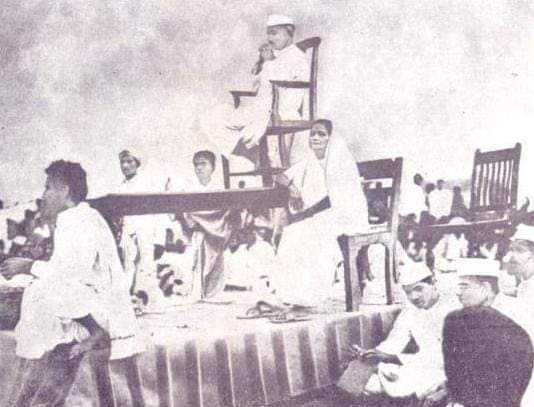In Loving Memory of My Idol

When he was six, his mother died. When he was twenty five, his wife, and when he was 28, all his three sons had died. And he himself died at 51.
Jagannath had never been so unkind to any man, perhaps. But He was no ‘any man’. He was fondly called by all Utkalamani (the Pearl of Odisha). Utkala is the ancient name of this land and mani in Odia is pearl.
Now read what the greatest Indian had said of him before I recount his immortal, multifarious deeds. This is what Mahatma wrote in Young India under the title ‘A Noble Soul Gone’ in 1928.
“As I am writing for Young India, I have
a wire from Nilakantha Babu apprising me of the death at Sakhigopal of Pandit Gopabandhu Das who was one of the noblest among the sons of Utkal, the land of sorrow and tears. Gopabandhu Babu had given his all to Odisha. I heard of him and his sterling character and steadfastness when Sj. Amritlal Thakkar was sent to Odisha in 1916 to distribute relief to the famine stricken. Sj. Thakkar used to write to me how Gopabandhu Babu braved inconvenience and disease in struggling to help the helpless. He gave up his practice and his membership of the Legislative Council during the non-cooperation days and never wavered. What was more at stake for him was the existence of his dearest Satyavadi School. His one ambition of life was to see dismembered Utkal united and happy. He had lately become a member of Lala Lajpatrai’s society and was planning to make Khadi an efficient vehicle for the economic relief of poverty and flood stricken Odisha. The Country is poorer for the death of Pandit Gopabandhu Das. Though he is not in our midst in the flesh, he is in our midst in the spirit.”
Moved! Well, now you will cry.
We’ve all seen Mother Teresa and her service for the poor and the destitute. But which man can leave his son, stricken by cholera and counting his last breath, to rush to distribute relief to the flood stricken villagers, comforting himself with the absurd thought,
“There are so many (people) to look after my son. What more can I do? But there are so many people crying for help in the affected areas and it is my duty to go there. Lord Jagannath is here to take care of the boy”. Weeping, you must be.
He established the first Odia newspaper, The Samaja to in 1919, last year celebrated a glorious century, so that the news of the flood and famine, those eternal companions of Odisha, reached the ears of the government and relief could reach the suffering people.
He established a residential school, in the sylvan surrounding of Sakhigopala, christened Satyavadi Vana Vidyalaya, in the first decade of the last century. Sakhigopala is just fifteen miles from Puri and famous for coconut trees and Sakhi Gopala temple. The idea was to teach students in the hoary Indian tradition of Gurukula, surrounded by lush green trees. He was born in an orthodox Brahmin family but inspired by Mahatma and the Catholic spirit of Odisha decided to welcome Harijan students to his school, dined with them and started a social revolution of sorts all over Odisha much before Mahatma made it his mission. In Odisha, there are two kinds of castes who bear the surname Das. If you add ‘h’ after Das, you are born a Brahmin and without it you are low caste. He dropped the glottal consonant from his surname to show solidarity with the lower caste. The idea caught on among the progressive Odias, so much so that my father’s family, super orthodox Brahmins, dropped ‘h’ from their title. My father and paternal uncles never signed themselves Dash but Das.
He united the divided Odisha which, by her miserable destiny and colonial politics, was just limited to a few coastal districts. He inspired the idea of formation of state on the basis of language and you must know that Odisha, as you see it today, was born, yes, eleven years before India’s Independence. The first state to be formed on the basis of language but since it was made before freedom, Andhra Pradesh bagged the title of the pioneer in 1956.
He was not just a lawyer, a member of Provincial Assembly, an educator, a founder of a school, a newspaper, an editor but a poet of the first order. In fact, my love for him began with his poetry. Now ask any Odia about this saint- political leader, the first words would drop from their mouths are,
ମିଶୁ ମୋର ଦେହ ଏ ଦେଶ ମାଟିରେ
ଦେଶ ବାସୀ ଚାଲି ଯାଆନ୍ତୁ ପିଠିରେ,
ଦେଶର ସ୍ଵରାଜ୍ୟ ପଥେ ଯେତେ ଗାଡ଼
ପୁରୁ ତହିଁ ପଡି ମୋର ମାଂସ ହାଡ଼ ।
(Let my body be mingled with the earth of my country,
Let my countrymen walk on my back
Let the pot-holes on the path of freedom
Be filled up by my flesh and bones.)
The man who had suffered so much for his own and for his country men’s pain, who had seen his near ones die one by one and his country men, flock by flock, perhaps couldn’t bear any more and breathed his last when he was just 51, on a glorious day, Bahuda Yatra, the day Jagannath Mahaprabhu returns to the Temple after nine day sojourn.
The picture celebrates a century this year. March 23, 1921. The place is the riverbed of the mighty tributary, Kathajodi, of the biggest river Mahanadi. Seated on the high chair, you guessed right, is 52 year old Mahatma Gandhi, his first visit to Odisha on the active, persistent prodding of his disciple, who, if you enlarge the picture can see, seated right on the platform floor, the 44 year old bearded President of that welcome meeting for Mahatma, Pandit Gopabandhu Das.
I must sign off with this line which has been a personal favourite for decades. Almost Keatsian, it says in a single line how devastating any loss of a kindred soul is,
ବନ୍ଧୁ
ତୁ ତ ଅନୁଭବୀ ନାହୁଁ
ସ୍ନେହ ଜାତ ସୁଖ, ତା ବିଚ୍ଛେଦ ଦୁଃଖ
ଯେ ଜାଣେ ସେ ଆସି କହୁ ।
(Buddy
You don’t know,
The joy born of affection,
The misery born of its loss
Let the one who knows come
and talk.)

Comments
So empty here ... leave a comment!